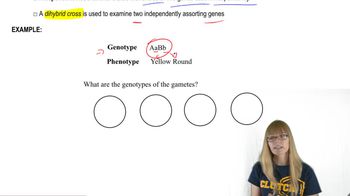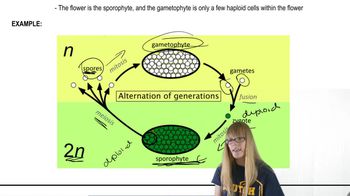Table of contents
- 1. Introduction to Genetics51m
- 2. Mendel's Laws of Inheritance3h 37m
- 3. Extensions to Mendelian Inheritance2h 41m
- 4. Genetic Mapping and Linkage2h 28m
- 5. Genetics of Bacteria and Viruses1h 21m
- 6. Chromosomal Variation1h 48m
- 7. DNA and Chromosome Structure56m
- 8. DNA Replication1h 10m
- 9. Mitosis and Meiosis1h 34m
- 10. Transcription1h 0m
- 11. Translation58m
- 12. Gene Regulation in Prokaryotes1h 19m
- 13. Gene Regulation in Eukaryotes44m
- 14. Genetic Control of Development44m
- 15. Genomes and Genomics1h 50m
- 16. Transposable Elements47m
- 17. Mutation, Repair, and Recombination1h 6m
- 18. Molecular Genetic Tools19m
- 19. Cancer Genetics29m
- 20. Quantitative Genetics1h 26m
- 21. Population Genetics50m
- 22. Evolutionary Genetics29m
3. Extensions to Mendelian Inheritance
Understanding Independent Assortment
Problem 33d
Textbook Question
An organism having the genotype AaBbCcDdEe is self-fertilized. Assuming the five genes assort independently, determine the following proportions:
gametes that are expected to be ABcde
 Verified step by step guidance
Verified step by step guidance1
Identify the genotype of the organism: AaBbCcDdEe.
Determine the possible alleles for each gene: A or a, B or b, C or c, D or d, E or e.
Recognize that each gamete will receive one allele from each gene pair.
Calculate the probability of obtaining the specific gamete ABcde by multiplying the probabilities of each allele: A from Aa, B from Bb, c from Cc, d from Dd, and e from Ee.
Since the genes assort independently, the probability of each allele is 1/2, so multiply these probabilities together to find the overall probability of the gamete ABcde.
Recommended similar problem, with video answer:
 Verified Solution
Verified SolutionThis video solution was recommended by our tutors as helpful for the problem above
Video duration:
2mPlay a video:
Was this helpful?
Key Concepts
Here are the essential concepts you must grasp in order to answer the question correctly.
Independent Assortment
Independent assortment is a fundamental principle of genetics stating that alleles for different genes segregate independently of one another during gamete formation. This means that the inheritance of one trait will not affect the inheritance of another, allowing for a variety of combinations in the offspring.
Recommended video:
Guided course

Gamete Genetics and Independent Assortment
Gamete Formation
Gamete formation involves the process of meiosis, where diploid cells divide to produce haploid gametes. In the case of the genotype AaBbCcDdEe, each gene can contribute one of its two alleles to the gametes, leading to a diverse array of possible combinations based on the alleles present.
Recommended video:
Guided course

Formation of Plant Gametes
Probability in Genetics
Probability in genetics is used to predict the likelihood of certain genotypes or phenotypes occurring in offspring. By calculating the probability of each allele combination, one can determine the expected proportions of specific gametes, such as ABcde, from the self-fertilization of the organism with the given genotype.
Recommended video:
Guided course

Probability

 4:58m
4:58mWatch next
Master Gamete Genetics and Independent Assortment with a bite sized video explanation from Kylia Goodner
Start learningRelated Videos
Related Practice

